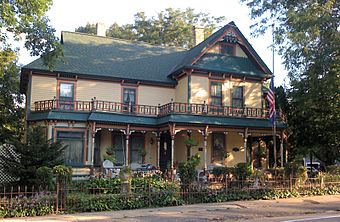Carver Historic District facts for kids
Quick facts for kids |
|
|
Carver Historic District
|
|

The 1891 John Hebeison House within Carver Historic District
|
|
| Location | Roughly bounded by Lime, 1st, Walnut and 6th Streets, Carver, Minnesota |
|---|---|
| Area | Approximately 60 acres (24 ha) |
| Built | 1852–1900 |
| MPS | Carver County MRA |
| NRHP reference No. | 80001960 |
| Designated HD | January 4, 1980 |
The Carver Historic District is a special area in Carver, Minnesota. It's like a time capsule! This district was added to the National Register of Historic Places in 1980. It's important because of its amazing old buildings. These buildings show us how people lived and worked long ago. Most of them were built between 1855 and 1880. The district has about 100 historic buildings. It's known for being a well-preserved old town along the Minnesota River. It also has the most important historic buildings in Carver County.
Contents
Discovering Carver's Past
How Carver Began
The city of Carver was one of the first towns in Carver County. It sits right on the Minnesota River. Many early settlers coming to Carver County first stopped here. From Carver, they would then travel to other towns and farms.
A Norwegian immigrant named Axel Jorgenson settled in this area in the winter of 1851–1852. In 1854, Jorgenson sold his land. A group of investors from Saint Paul bought it. They called themselves the Carver Land Company.
Minnesota's first governor, Alexander Ramsey, was part of this group. He suggested the name "Carver" for the town. He named it after Jonathan Carver, an explorer who first explored this region.
Carver's Early Growth
By 1855, the town of Carver was already growing fast. It had many important businesses. These included a tailor, a hotel, and a boarding house. There was also a building designer, a carpenter, and a blacksmith. Two shoemakers and a general store also served the town.
By 1857, Carver had 35 buildings. It became a main stopping point for trade and travelers. People used the Minnesota River to move goods and for their journeys. By the 1890s, Carver was one of the biggest settlements in Carver County.
Changes and Challenges
Carver's future changed when river trade slowed down. This happened because railroads were being built. The new railroads often bypassed Carver. This meant businesses and people started using the trains instead of the river.
The Prohibition Era (from 1920 to 1933) also caused problems. During this time, many saloons and hotels had to close. Carver became a poorer town.
However, this lack of money actually helped save many historic buildings. There wasn't enough money for new construction. So, old buildings were not torn down.
Saving Carver's History
More was needed to protect the town's historic buildings for the future. So, on June 25, 1969, a non-profit group was formed. It was called Carver-on-the-Minnesota, Incorporated.
This group started raising money. They bought buildings that needed repairs. This was the beginning of the Carver Historic District.
Carver-on-the-Minnesota created plans to restore buildings. They also made rules for how restorations should look. They became a great source for researching historic buildings. Their work helped save even more buildings.
In 1980, the old town of Carver became one of Minnesota's first historic districts. This was largely thanks to the work of this organization. The Carver Historic District now has 87 buildings and four other important structures.
You can see special signs on many buildings in the district. These signs show they are on the National Register. The buildings include homes, businesses, churches, and public buildings. They were built between 1852 and 1925. Many have been restored to their original look.
Protecting the Future
In February 1989, the city of Carver created a Heritage Preservation Commission. Their goal was to help the City Council and other groups. They work to protect Carver's historic places.
In 2007, the federal government named Carver a Preserve America community. Carver was only the eighth town in Minnesota to receive this honor. This shows how important its history and preservation efforts are.



